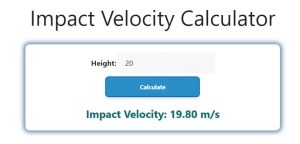About Impact Velocity Calculator (Formula)
The Impact Velocity Calculator is a valuable tool for anyone interested in physics, engineering, or any field that involves the motion of objects. Impact velocity refers to the speed at which an object strikes a surface after falling from a certain height. Understanding this concept is crucial for safety assessments, material selection, and various applications in engineering and design. By accurately calculating the impact velocity, you can predict the forces involved during collisions and optimize structures for safety and performance.
Formula
The formula for calculating impact velocity (v) is:
v = √(2 * g * h)
Where:
- v is the impact velocity (in meters per second, m/s),
- g is the acceleration due to gravity (approximately 9.81 m/s² on Earth),
- h is the height from which the object is dropped (in meters).
How to Use
- Determine the Height (h): Measure the height from which the object will fall in meters.
- Use the Gravitational Constant (g): For Earth, use the value 9.81 m/s² for g.
- Input the Values: Substitute the values of g and h into the formula.
- Calculate: Use a calculator or compute manually to find the impact velocity (v).
Example
Suppose you want to calculate the impact velocity of a ball dropped from a height of 20 meters.
- Height (h): 20 meters
- Gravitational Constant (g): 9.81 m/s²
- Calculation:
v = √(2 * 9.81 * 20)
v = √(392.4)
v ≈ 19.81 m/s
Thus, the impact velocity of the ball when it strikes the ground will be approximately 19.81 m/s.

FAQs
- What is impact velocity?
Impact velocity is the speed of an object just before it strikes a surface. - How does height affect impact velocity?
The greater the height from which an object is dropped, the higher its impact velocity will be upon hitting the ground. - Is the gravitational constant always the same?
On Earth, it is approximately 9.81 m/s², but it varies slightly depending on location and altitude. - Can this formula be used for other planets?
Yes, but you must adjust the value of g to match the acceleration due to gravity on that planet. - What are some practical applications of calculating impact velocity?
Applications include vehicle safety design, sports equipment testing, and understanding fall-related injuries. - Does air resistance affect impact velocity?
In ideal conditions (ignoring air resistance), the formula provides an accurate value. However, air resistance can slow down the object, reducing the impact velocity. - What units are used in this calculation?
Height should be in meters, and the resulting impact velocity will be in meters per second (m/s). - How can I measure the height of a drop accurately?
Use a measuring tape, laser distance measurer, or any reliable measuring device suitable for the height you are measuring. - What happens to impact velocity if the object is dropped from a greater height?
The impact velocity increases as the height increases due to the higher potential energy being converted to kinetic energy. - Is there a maximum height at which this formula is valid?
In theory, the formula is valid for any height; however, practical considerations, like air resistance and structural integrity, may come into play at extreme heights. - Can I use this calculator for a projectile launched at an angle?
This specific formula applies to free-fall scenarios. For projectiles, you would need to consider additional factors like initial velocity and angle. - What if I drop multiple objects at the same height?
All objects, regardless of mass, will have the same impact velocity if dropped from the same height (ignoring air resistance). - Can I calculate impact velocity for objects falling in a vacuum?
Yes, in a vacuum, where there is no air resistance, all objects will fall at the same rate, and the formula will apply perfectly. - How does the impact velocity change with time?
Impact velocity increases linearly with time until the object strikes the ground, as it accelerates due to gravity. - What is the relationship between potential energy and impact velocity?
The potential energy at height is converted to kinetic energy at the moment of impact, determining the velocity. - Are there safety considerations related to impact velocity?
Yes, understanding impact velocity can help in designing safety measures, such as padding, helmets, and barriers to protect against injuries. - What kind of objects can this calculator be used for?
It can be used for any object that falls freely, such as balls, stones, and even vehicles under certain conditions. - How can I apply this knowledge in real life?
You can use it to assess risks in various scenarios, like sports, construction, and material testing. - What software or tools can help with these calculations?
Many scientific calculators, physics simulation software, and online calculators can help compute impact velocity. - How can I ensure accurate measurements?
Always double-check your height measurements and calculations, and consider any external factors that could influence the drop.
Conclusion
The Impact Velocity Calculator is an essential tool for understanding the dynamics of falling objects. By using the provided formula, anyone can quickly determine the speed at which an object will strike the ground from a given height. This knowledge is not only crucial for physics students but also for engineers, designers, and safety professionals involved in various fields. Understanding impact velocity helps in designing safer environments and products, ultimately contributing to public safety and welfare.